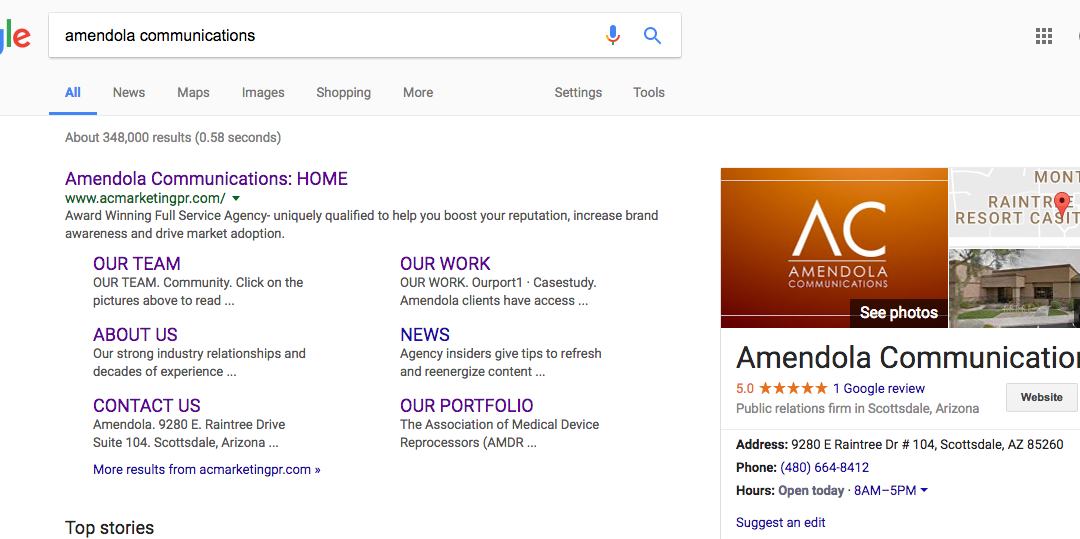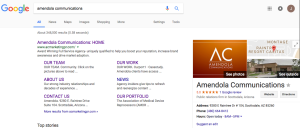
by Brandon Glenn | Jan 8, 2020 | Blog
The more corporate blogs change, the more they stay the same.
A 2016 post on Amendola’s blog lists the primary benefits a corporate blog can deliver, which all ring true three-and-a-half years later. Those advantages include: building SEO and attracting visitors to your site, providing a platform to exchange ideas with prospects and customers, strengthening your brand, serving as the
hub of your content marketing efforts, and establishing you as thought leaders in the industry.
Likewise, the author’s assessment of the most likely factor to derail a corporate blog remains spot-on: “The number one barrier I have encountered to establishing thought leadership through a corporate blog is a lack of commitment. A blog will die a slow (or sometimes not-so-slow) death when an organization fails to develop a culture committed to establishing thought leadership through content marketing.”
This observation matches up with my own experience. Too often, corporate blogs are launched without a detailed plan and content calendar that organize and map out the content the blog is planned to cover.
There is one piece of advice from the author, however, that I believe doesn’t fully capture the idea of how to maintain a sustainable blog: “The executive team must lead the way.” Certainly, that is true in regard to the need for executives to champion the blog internally to generate interest within the company.
However, this advice ignores the role the marketing and communications teams must play in developing potential content for the blog. While an organization’s top executives are certainly its most prominent thought leaders, they generally are reluctant to spend time sitting in front of a blank Word document brainstorming ideas for corporate blog posts. That’s why the organization’s marketing and communications professionals must first take the lead in establishing a content plan for a blog.
How is this accomplished? Start by reviewing any recent content your company has produced that is still relevant, which may include white papers, guest editorials, marketing collateral, website copy, interview transcriptions and more. This pre-existing content can be a gold mine of ideas to repurpose for blog posts.
Take your preparation a step further by performing Google and Twitter searches for news items relevant to your company that provide a jumping-off point for other blog posts. For example, if your company works with provider organizations to help address social determinants of health issues in their communities, a simple search of “social determinants of health” may yield information about a trove of articles and studies that can provide engaging content for blog posts.
Use this research to fuel a running list of corporate blog post ideas that you update periodically and share with your thought leaders. By doing this, you’ll likely have saved executives lots of time and even have taken on the appearance of a thought leader a bit yourself.

by Ken Krause | Jun 12, 2019 | Blog
Whether you personally believe trade shows are the land of opportunity or merely a relic of a bygone era where primitive being skulked through the aisles without the benefit of a smartphone, there is no question that they are still a fact of life for many of us. In fact, some (such as, oh, I dunno, HIMSS?) are not merely a minor blip on our radars but a huge disruptor to the otherwise semi-orderly flow of our lives.
Trade shows can be a time-sink as well as a budget-sink, so if you’re going to make that type of investment, it’s critically important that you be sure the organization gets something out of it. Something more than “exposure” and free leftover pens, tote bags and the kind of hard candy your grandmother gives you when you come to visit, and that you only eat when there is absolutely no other choice. Love you, grandma!
Toward that end (getting something out of your trade show investment, not getting hard candy), Amendola Communications CEO Jodi Amendola has written a blog post in her role as a member of the Forbes Agency Council. “Trade Show ROI: Four Ways to Make the Most Out of Industry Events” offers some great suggestions for ensuring marketers get a pat on the back rather than a kick in the backside for the results of their organization’s trade show efforts. The four tips include:
- Ensuring you have a well-honed elevator pitch that carefully walks the line between proper and over-the-top self-promotion
- Making Twitter your go-to social media platform for engaging other attendees
- Hosting a reception for clients and prospects
- Being sure you do something with all those leads you capture
Obviously there’s more to it than just those four bullet points, so it’s well worth giving the post a full read. You can do that here.
Whatever your personal feelings about trade shows, however, they still loom large in many industries – especially healthcare. So if you’re going to do it, do it right.
Take the time to prepare properly, and then maximize your time on the floor – whether you’re in front of the counter or behind it. It will pay off in the end.

by Jenna Warner | May 24, 2017 | Blog
Grab your Instagram-worthy coffee and make sure you are not guilty of these social media crimes.
Social media marketing is fast paced. Not only does your well thought-out and carefully sliced up 140-character tweet have a short shelf life, but each platform changes almost daily. However, there are some nuances that remain the same. These are my top 5 mistakes to avoid in the ever-evolving social media game.
1. Use old, wrong or low-quality logos
Twitter’s logo is a bird, not a plane and not a weird version of tumblers “t”. The official logo became the bird with no text in 2012. No, I’m not paid by Twitter’s branding manager, but I am fired up about getting everyone on the same page about the logo misuse!
Whenever you need a social media platform’s logo, it is best to visit their branding guidelines or resources. Usually, you can download a free kit that has the logo in many colors and every type of file format.
Another important logo faux pas to watch out for is the dreaded, low-quality profile picture or thumbnail. Nothing screams “We don’t care about this” more than a bad photo as your profile picture. It’s the first impression your potential customers see and you want it to be a good one! Don’t forget to look at your  entire digital presence to make sure you have at least one high-quality photo listed with your brand. Google search is a commonly missed opportunity. Don’t worry, it’s an easy fix! Google uses their very own social network information first to populate the search results side bar. Make sure you gave a great photo or high-quality logo and accurate information listed on your Google+ account.
entire digital presence to make sure you have at least one high-quality photo listed with your brand. Google search is a commonly missed opportunity. Don’t worry, it’s an easy fix! Google uses their very own social network information first to populate the search results side bar. Make sure you gave a great photo or high-quality logo and accurate information listed on your Google+ account.
2. Spam following attacks
Managers that do this are like the sign spinners of social media marketing.
I understand how this strategy developed as you can get short-term results from using this tactic. But these followers are hardly worth your efforts and are most likely either spam-bots or accounts that are not linked to your decision makers.
You should still keep your ratios clean (follow fewer accounts than you have followers) and follow industry leaders and influencers. The key is to focus your efforts when it makes sense for your strategy, not sporadically and aggressively. Twitter will actually step in when it becomes too much of a problem, but please, never get to that point.
3. Miss an engagement or sales opportunity
Uh, hello? It’s called SOCIAL media. Be social! Especially if you are a B2B organization, this type of engagement just isn’t as common as the B2C counterparts on social media. Capitalize on the opportunity as it arises! There is no shortage of free software available to help manage your engagement. Find brand champions that aren’t tagging your account, yet still praising your name, fix customer problems or complaints and develop new sales leads.
Make sure your engagement is timely and relevant. Search all hashtags used or links shared before posting or replying. Also, make sure the account you are engaging with is a real person not just a bot or an irrelevant twitter user.
4. Forget to sign out of the company account
Yikes! This is an ugly one. People get fired over this and it is not a great situation to be in. Personally, as a practicing social media manager, I steer clear of posting politics on my personal social accounts and I keep it PG. This choice decreases my risk of posting something truly terrible on a company account. Newton’s law of gravity doesn’t apply to the internet. What goes up, stays up on the internet.
There are too many examples like the twitter accident that happened to Chrysler.

5. Assume you have learned everything
The beauty and challenge of social media marketing is that it’s always changing. It’s hard to be the ultimate expert in something that is always changing and moving! Stay in touch with reality and assume there is always something new to learn and observe. I find it to be the best way to approach social media.
Hashtag conversations and meanings can change hourly, platforms have repositioned based on users habits and algorithms change all the time! The Internet is a place where traditional marketing practices and new forms of communication can be used in collaboration to create meaningful engagements with your audience.
Here are a few methods I use to stay up-to-date on my social media marketing skills:
Use social media platforms for personal use
Read and subscribe to social media marketing blogs and news outlets
Listen to podcasts on the digital strategy
Attend webinars on social media marketing
Look at competitors or other industries and figure out what is working for them
Make sure not to commit any of these social media mistakes and comment below with other social media rules that stand the test of time.





